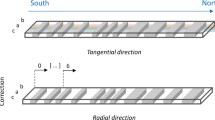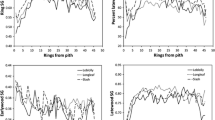Abstract
-
• Wood density is a characteristic of major interest. Usually, it is used as an indicator of wood quality; however, in the context of global change, it is increasingly used for biomass and carbon storage estimations. X-ray computer tomography is a method which enables quick estimates of wood density after applying a calibration procedure.
-
• A review of the literature is presented in this article. Most of the previous studies have been performed in the 80’s or at the beginning of the 90’s.
-
• In this study, the relationship between wood density and Hounsfield numbers was investigated using a recent medical scanner. A linear relationship was fitted using a calibration data set which consisted in tropical wood samples representing a large range of densities ranging between 133 and 1319 kg m−3, and then validated using an independent data set (mainly temperate tree species). The fitted relationships were very strong (R 2 > 0.999), whichever the tested scanner settings, with slight but significant effects of the current voltage and reconstruction filters. The RMSE values computed from the validation data set ranged between 5.4 and 7.7 kg m−3 for densities ranging between 364 and 821 kg m−3.
-
• In conclusion, this method of calibration enables the use of a medical scanner to obtain maps of wood density, in a fast and non destructive way, and with a very good accuracy. Very interesting perspectives are opened regarding biomass distribution within trees.
Résumé
-
• La densité du bois est une caractéristique d’intérêt majeur. Généralement, elle est utilisée comme un indicateur de la qualité du bois ; cependant, dans le contexte du changement global, elle est de plus en plus utilisée pour des estimations de biomasse et de stockage de carbone. La tomographie à rayons X est une méthode permettant des estimations rapides de la densité du bois moyennant une procédure de calibration.
-
• Une revue de la littérature sur le sujet est présentée dans cet article. La plupart des études précédentes ont été réalisées dans les années 80 ou au début des années 90.
-
• Dans cette étude, la relation entre la densité du bois et les nombres Hounsfield a été étudiée en utilisant un scanner médical récent. Une relation linéaire a été ajustée sur un jeu de données de calibration constitué d’échantillons de bois tropicaux représentant une large gamme de densités allant de 133 à 1319 kg m−3, et validée sur un jeu de données indépendant (principalement des essences tempérées). Les relations ajustées étaient très fortes (R 2 > 0.999) quels que soient les réglages utilisés pour le scanner, avec des effets légers mais significatifs de la tension d’accélération et des filtres de reconstruction. Les valeurs des RMSE calculées à partir de l’échantillon de validation sont comprises entre 5.4 et 7.7 kg m−3 pour des densités allant de 364 à 821 kg m−3.
-
• En conclusion, la méthode de calibration proposée permet l’utilisation d’un scanner médical pour obtenir de façon rapide et non destructive des cartes de densité du bois avec une très bonne précision. Des perspectives très intéressantes sont ouvertes concernant la répartition de la biomasse dans les arbres.
Similar content being viewed by others
References
Benson-Cooper D.M., Knowles R.L., Thomson F.J., and Cown D.J., 1982. Computed tomographic scanning for the detection of defects within logs. FRI Bulletin, Forest Research Institute, New Zealand, 9 p.
Crawley M.J., 2007. The R book, John Wiley & Sons, 942 p.
Davis J. and Wells P., 1992. Computer tomography measurements on wood. Industrial Metrology 2: 195–218.
Espinoza G.R., Hernandez R., Condal A., Verret D., and Beauregard R., 2005. Exploration of the physical properties of internal characteristics of sugar maple logs and relationships with CT images. Wood Fiber Sci. 37: 591–604.
Fromm J.H., Sautter I., Matthies D., Kremer J., Schumacher P., and Ganter C., 2001. Xylem water content and wood density in spruce and oak trees detected by high-resolution computed tomography. Plant Physiol. 127: 416–425.
Funt B.V., 1985. A computer vision System that analyzes CT-scans of sawlogs. Proceedings of IEEE Conference on Computer Vision and Pattern Recognition, San Francisco, California, pp. 175–177.
Hattori Y. and Kanagawa Y., 1985. Non-destructive measurement of moisture distribution in wood with a medical X-ray CT scanner I. Accuracy and influencing factors. Mokuzai Gakkaishi 31: 974–980.
Lindgren L.O., 1991a. The accuracy of medical CAT-scan images for non-destructive density measurements in small volume elements within solid wood. Wood Sci. Technol. 25: 425–432.
Lindgren L.O., 1991b. Medical CAT-scanning: X-ray absorption coefficients, CT-numbers and their relation to wood density. Wood Sci. Technol. 25: 341–349.
Macedo A., Vaz C.M.P., Pereira J.C.D., Naime J.M., Cruvinel P.E., and Crestana S., 2002. Wood density determination by X- and gamma-ray tomography. Holzforschung 56: 535–540.
Mull R.T., 1984. Mass estimates by computed tomography: physical density from CT numbers. Am. J. Roentgenol. 143: 1101–1104.
Parr D.G., Stoel B.C., Stolk J., Nightingale P.G., and Stockley R.A., 2004. Influence of Calibration on Densitometric Studies of Emphysema Progression Using Computed Tomography. Am. J. Respir. Crit. Care Med. 170: 883–890.
Rathgeber C.B.K., Decoux V., and Leban J.M., 2006. Linking intra-treering wood density variations and tracheid anatomical characteristics in Douglas fir (Pseudotsuga menziesii (Mirb.) Franco). Ann. For. Sci. 63: 699–706.
Saw C.B., Loper A., Komanduri K., Combine T., Huq S., and Scicutella C., 2005. Determination of CT-to-density conversion relationship for image-based treatment planning systems. Med. Dosim. 30: 145–148.
Taylor A.J., 2006. Wood density determination in Picea sitchensis using computerised tomography: how do density measurements compare with measurements of pilodyn pin penetration? University of Wales, Bangor.
Vallet P., 2005. Impact de différentes stratégies sylvicoles sur la fonction “puits de carbone” des peuplements forestiers. Modélisation et simulation à l’échelle de la parcelle. Doctoral thesis, École Nationale du Génie Rural, des Eaux et des Forêts, France.
Zianis D., Muukkonen P., Mäkipää R., and Mencuccini M., 2005. Biomass and stem volume equations for tree species in Europe. Silva Fenn. Monogr. 4: 2–63.
Author information
Authors and Affiliations
Corresponding author
Rights and permissions
About this article
Cite this article
Freyburger, C., Longuetaud, F., Mothe, F. et al. Measuring wood density by means of X-ray computer tomography. Ann. For. Sci. 66, 804 (2009). https://doi.org/10.1051/forest/2009071
Received:
Accepted:
Issue Date:
DOI: https://doi.org/10.1051/forest/2009071




